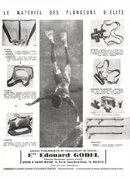David Wilson
Contributor
Beuchat included a snorkel-mask in its range.
Beuchat Snorkel diving mask




Stock code 125. The caption accompanying the last image reads "125 'Snorkel'. Masque permettant de respirer par le nez", meaning "125 'Snorkel'. Mask enabling breathing through the nose". Note from the second and third images how this mask covers the eyes and the nose, leaving the mouth uncovered. It is a myth that all, or even most, first-generation snorkel-masks came with full face coverage. The Beuchat snorkel-mask features a single swan's neck type tube topped with a ball valve and leading into the mask interior via a bracket installed centre top on the mask. When such masks were introduced, they were designed to serve the needs of spearfishermen who seldom had their hands free to insert and remove separate snorkels in the mouth. It is also a myth that these devices were first marketed as children's toys.
Beuchat Snorkel diving mask
Stock code 125. The caption accompanying the last image reads "125 'Snorkel'. Masque permettant de respirer par le nez", meaning "125 'Snorkel'. Mask enabling breathing through the nose". Note from the second and third images how this mask covers the eyes and the nose, leaving the mouth uncovered. It is a myth that all, or even most, first-generation snorkel-masks came with full face coverage. The Beuchat snorkel-mask features a single swan's neck type tube topped with a ball valve and leading into the mask interior via a bracket installed centre top on the mask. When such masks were introduced, they were designed to serve the needs of spearfishermen who seldom had their hands free to insert and remove separate snorkels in the mouth. It is also a myth that these devices were first marketed as children's toys.











